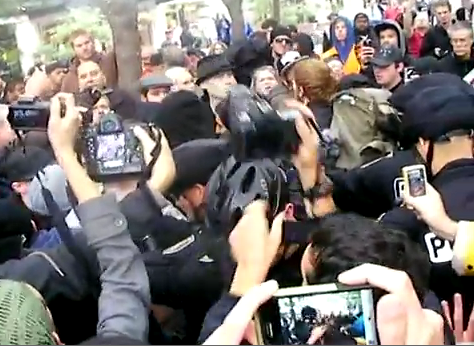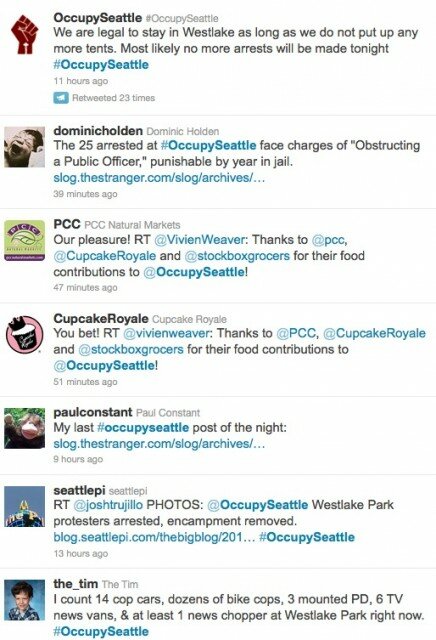We do not know how long this vintage ride has been on the force, but can vouch for its existence, as our trip through downtown yesterday happened upon it in this exact same spot. Thanks to +Russ for having a camera at the ready when his sighting occurred. See any other unique vehicles around town? Be sure to get some photographic evidence and then add it to our Flickr pool.
Tag Archives: police
Newyorkland Kicks in Doors of Cops’ Hearts at On the Boards
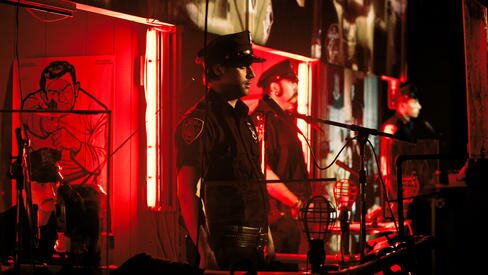
You’re listening to the Beastie Boys sing-scream “Sabotage” before Newyorkland begins at the On the Boards (tonight and Sunday night; tickets: $25), and you’re inspecting Kenneth Collins’s hectic set, part bunker, part safety-window and microphone, part blank screen onto which projections will appear. On your left, two cops, arms folded, watch the crowd from the shadows of the stage. On your right, another two, surveying, seemingly in casual conversation, but always with an eye out.
There’s an ancient wall-mounted rotary phone, a tiny portable TV, a manual typewriter. Masses of power cords of varying colors coil haphazardly in front of the cops’ box, as if its electrical guts have spilled out. All the bare bulbs have those protective baskets around them.
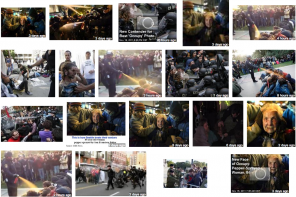
This is particularly delicate time to attempt this act of empathy, with police abusing the use the pepper spray across the country, but Newyorkland is not an apologia–it suggests only that cops are not born authoritarian goons, which depending on who you are may be a high or low bar. What is remarkable about the performance is its amplification of your senses, so that you begin a sensory immersion into Newyorkland, not a rationalized one. (John Sully’s music and soundscape is integral to the piece.)
From the moment the miked typewriter clacks at you out of the darkness, officers taking calls alternately horrific and trivial with the same detached dispatch, office scenes–memories, dreams, reflections, shot by William Cusick, riffs on classic ’70s police dramas and Steadicam documentaries–playing out on the wall, you enter a grubby hologram of police work, where it is never entirely clear what is what. A target range figure of a man with a gun keeps intruding into your consciousness at odd moments.
At issue is a bait-and-switch: Temporary Distortion’s creative team interviewed police they knew, researched reams of interviews and case files, and collated the mass into spoken-word collage: Cops (performed by Nick Bixby, Daniel Brown, Al Di Martino, Brian Greer) talk about how they came to join the force, drawn by the status, the pension–but often as well because of the urge to protect people.
Yet, the cops say, there’s a profound disillusionment when you discover that your primary task is to regulate the behavior of people who see themselves as free citizens. It’s human nature, as one says, to “bridle” at someone telling you what to do. Newyorkland explores that role, of glorified hall monitor, dealing with raging cases of oppositional defiance disorder, and the square-peggishness of sending armed people out to defuse arguments.
The work is an “assemblage,” say its creators, and it’s worth noting that so is cop life. In contrast to the tidy narrative arcs of TV police procedurals, here the mundane paperwork, dreamworld nightshifts, batshit crazy felons, and domestic stress collide in no particular order, sound and fury signifying nothing in particular–the cops join in a searing “walking wounded” fugue: people are scum, animals, filth, that’s the job, do the job, don’t let the job do you, keep your head on a swivel, etc.
“New York City officers kill themselves at a rate of 29 per 100,000 a year,” about twice the rate of the general population. That’s the kind of didacticism that’s not present in this work, though there is a monologue from a profoundly disturbed officer, and a memorial ritual, to the words of “Taps.” You know the work must be drawing to a close, but you don’t want it to, to have this strange window slide shut.
Hordes of Journalists Occupy Westlake Park, Disrupting “Occupy Seattle” Protesters
Follow the story of Seattle’s ragtag band of #occupyseattle protesters on Twitter. They’re back this morning, after Seattle police gave the protesters a little taste of what it’s like to be homeless–by forcibly removing their tents from Westlake Park. I suppose that’s to be expected: When you declare solidarity with the poor, you get treated like them. Since there’s nothing worse than holding a protest that no one notices, the police action most likely did the protesters a big favor. Occupy Seattle the Twitter account says that hearings for those arrested yesterday begin at 10 a.m. at the King County Courthouse.
Looking for a Fix on Third Avenue
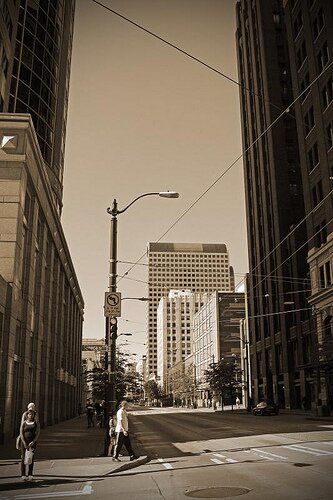
Ironically, it is fairly easy to get a fix on Third Avenue in Seattle (or get stabbed or beaten nearly to death) because it has become the entrenched home of a large open-air drug market. But the City of Seattle has so far struggled to fix that problem. Better crowd control late-night, when bars are letting out, has helped reduce aggressive brawling, and despite bullets flying less frequently, overall confidence in personal safety is still low.
It’s not that the City is unaware. The City Council’s Tim Burgess writes on his blog: “Residents and small business owners in Belltown send a steady stream of complaints to Council members and the Mayor asking why drug dealers are allowed to sell heroin and cocaine with near impunity near their homes and shops.” Let’s start, he suggests, “with an increased presence of uniformed police officers.”
Burgess also thinks Third Avenue could use a facelift in general:
It should be converted into a restricted “complete street” that serves only transit, pedestrians, bicycles, and delivery and emergency vehicles all day. Sidewalks could be expanded and streetscape improvements installed, such as hanging flower baskets and other “green” enhancements, public art, wayfinder signage, and additional lighting.
Is it possible to stop Belltown’s illegal drug market?, asks Seattlepi.com. A 2009 sweep of drug dealers, reports Casey McNerthney, led to 32 being charged. But they soon popped up again. SeattleCrime.com’s Jonah Spangenthal-Lee calls them “catch-and-release drug arrests.” Newly ensconced at Publicola, Spangenthal-Lee details the city’s new drug diversion program, which seeks to separate the major dealer wheat from the small-time chaff.
Beginning October 1st, small-time drug dealers and drug users arrested with less than three grams of crack, heroin, meth or drug paraphernalia in Belltown by members of SPD’s West Precinct Anti-Crime Team and bike patrol officers will be given the option to go to diversion DEFINE or go to jail as part of the Law Enforcement Assistance Diversion (LEAD) pilot program.
Essentially, the program tries to distinguish between addicts selling (or carrying) to support their own habit, and the more troublesomely entrepreneurial dealer. Addicts will get “housing, social security benefits, job training, or on-the-spot treatment,” and aren’t booted from the program for relapsing, as addicts will do. If there’s an 80/20 rule in effect, this should have the effect of emptying the sidewalks and pocket parks of small-time illegal activity, providing less cover for the serious drug dealers.
“LEAD, which costs about $1 million a year,” says Spangenthal-Lee, “already has enough funding to run for the next four years.”
